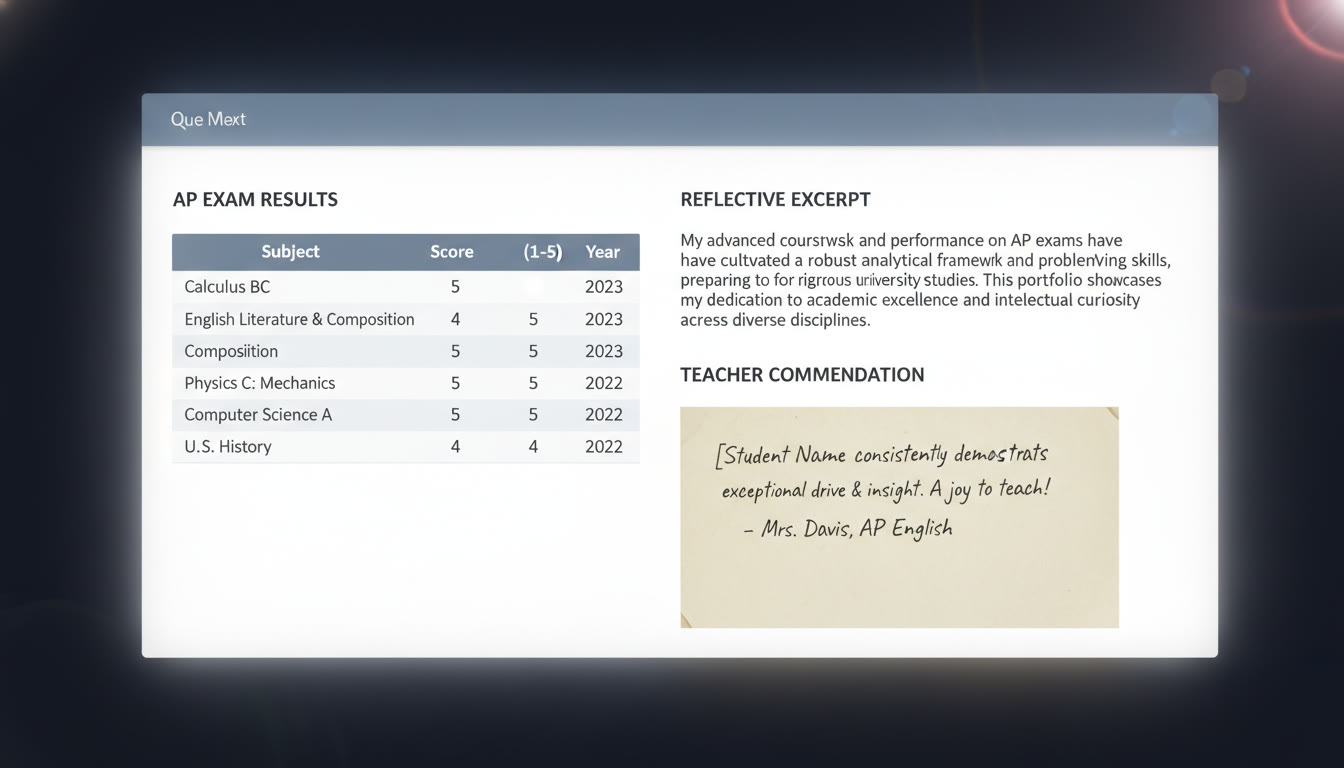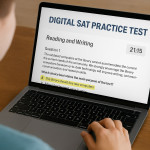Why Create a Personal Learning Transcript From AP?
Think of a personal learning transcript as the story behind your AP scores — a document that not only lists exams and numbers but also reveals how you learned, failed, adapted, and ultimately grew. For many students, a set of AP scores on the official College Board report does its job: colleges see the objective results. But admissions officers, scholarship committees, internship mentors, or even your future self often want more. They want context. They want to know what those scores mean: Did you teach yourself calculus over the summer? Did an AP Research project transform how you ask questions? Did a lower-than-expected score come after weeks of illness or caring responsibilities?
Creating a personal learning transcript turns raw data into a narrative of resilience, initiative, and intellectual curiosity. It’s also a versatile tool: useful for college applications, transfer credit petitions, scholarship essays, and even job or internship portfolios.
Who Should Make One?
- Current high school students taking AP exams who want to show the story behind the numbers.
- Rising college freshmen who want to petition for credit or advanced placement.
- Students with nontraditional academic paths — homeschooling, dual enrollment, gaps, or international study.
- Anyone who wants a reflective document for self-assessment and learning strategy planning.

Core Components of a Personal Learning Transcript
At its heart, a personal learning transcript combines objective records and subjective reflections. Here’s a practical breakdown of what to include and why:
1. Objective Academic Record
- AP Exams Taken — list each exam, the year taken, and the score received.
- Coursework — whether you took AP Classroom-based courses, self-studied, or took concurrent college classes that align with AP content.
- Official Score Reports — note how you obtained official verification (e.g., College Board online score report, archived score request, mailed score report).
Tip: Keep copies of your official AP Scores PDF from the College Board for quick attaching to digital portfolios or petitions. If some scores are archived (for exams taken before 2018 or under certain circumstances), document the archive request process and dates so recipients know how to verify them.
2. Evidence of Mastery
- Sample Work — lab reports, essays, project summaries, portfolios, or research abstracts that align with the AP subject.
- Free-Response Booklet Pages — if you requested a copy of your free-response booklet, annotate what you learned and how you would approach similar questions differently now.
- Teacher Evaluations — short statements from AP teachers or mentors that highlight areas of strength, growth, and classroom engagement.
3. Contextual Notes
Context can change how a score is interpreted. Include concise notes when relevant:
- Testing conditions (illness, accommodations, late testing date).
- Extracurricular commitments or work hours during study periods.
- Any withheld or canceled score requests and the reason (e.g., you withheld a score to re-evaluate or to request rescoring where applicable).
4. Reflection and Growth
Reflection is what makes the transcript personal. For each AP course/exam, add a short paragraph (150–300 words) covering:
- What you learned beyond the curriculum.
- Specific skills developed (analysis, lab technique, rhetoric, data modeling, experimental design).
- What you would do differently and next steps for deeper learning.
5. Transfer and Placement Goals
If your goal is college credit or placement, clearly state the intended use of each exam (credit, placement into an advanced course, or both), and identify the target institution’s policy if known. Briefly outline any supplemental coursework or assessments you’re prepared to take if the college requires them.
How to Structure the Document
Structure brings clarity. A coherent layout helps reviewers find the information they need quickly while appreciating the narrative. Below is a recommended order.
Suggested Layout
- Cover Page — Student name, contact info, school, graduation year, and a one-sentence thesis: what this transcript communicates about you.
- Table of Contents — useful for longer portfolios.
- Summary Page — quick snapshot: AP exams, cumulative AP GPA if you calculate one, and primary learning themes (e.g., quantitative reasoning, scientific inquiry).
- Detailed Sections — one section per AP subject including objective record, evidence of mastery, context, and reflection.
- Supporting Documents — PDFs, scanned artifacts, teacher notes, certificates, and official College Board score PDFs or archived score request confirmations.
- Conclusion — your learning trajectory and the next academic goals.
Putting Numbers in Context: An Example Table
Below is a sample table you can adapt to summarize AP exams and intended uses. Make sure the table is clear and honest—don’t overclaim credit that your target college doesn’t grant.
| AP Exam | Year | Score | Evidence | Intended Use |
|---|---|---|---|---|
| AP Calculus BC | 2024 | 4 | Project: Numerical Methods Lab; teacher letter | Placement into Multivariable Calc |
| AP Research | 2025 | 5 | Research abstract, poster, teacher evaluation | Demonstrate research competency; strengthen application |
| AP English Language | 2023 | 3 | Essays, annotated bibliography | Supplemental evidence of writing growth |
Practical Steps: From Draft to Polished Transcript
Creating a compelling personal learning transcript is a project. Here’s a step-by-step plan you can follow over a few weeks.
Week 1: Gather Records
- Download or print your official AP Score Reports from the College Board. If a score is archived, request an archived score report or document your archive request.
- Collect coursework, graded assignments, lab reports, and free-response booklet copies if you requested them.
- Ask teachers for short evaluations or confirmations of work (specific, one-paragraph statements work well).
Week 2: Draft Sections and Reflections
- For each AP subject, write the objective entry (exam, year, score) and then a reflective paragraph explaining the learning arc.
- Quantify when possible (hours of research, number of drafts, datasets analyzed), but keep clarity and honesty as priorities.
Week 3: Assemble and Add Context
- Put together the cover page, summary, and table of contents. Format consistently.
- Insert the evidence and supporting documents. Use a clear file naming scheme if digital (e.g., 2025_APResearch_Proposal.pdf).
Week 4: Review and Tailor
- Have a teacher, mentor, or trusted peer read the transcript for tone, clarity, and accuracy.
- If you’re using the transcript for a specific audience (college, internship), adapt the summary and intended use sections to their priorities.
How to Use the Transcript Effectively
Once your transcript is polished, here are smart ways to use it:
- College Applications: Attach as an optional supplement when schools invite additional materials, or reference it in your application essays.
- Credit Appeals: Submit with petitions to registrar or placement offices to explain why your scores justify credit or advanced placement.
- Scholarship and Internship Applications: Use the transcript to show subject depth and research experience, especially when AP Research or AP Seminar are part of your portfolio.
- Personal Growth: Keep an updated copy to track learning milestones and to inform future study plans.
Common Questions and Practical Solutions
What if I have archived AP scores?
Don’t panic. If you took AP exams in years when scores were archived, you can request an archived score report from College Board by mail or fax, and they will send the report by first-class mail within a stated processing window. Include the confirmation of your archived score request in your transcript’s supporting documents so reviewers know how to verify your scores.
Should I include every AP score, even low ones?
Transparency matters. Include all AP exams and scores, but provide context for lower scores if they don’t reflect your capability (e.g., illness, late testing, limited prep time). A thoughtful reflection explaining what you learned from a lower score can be more compelling than silence.
How do colleges verify my claims?
Colleges typically verify official scores via the College Board score reporting system. In your transcript, note which scores are covered by official College Board reports and which may require archived requests. If you include teacher evaluations or sampled work, ensure that they are clearly dated and easily verifiable by contacting the teacher or school if requested.
Real-World Examples: How Students Turned Transcripts Into Opportunity
Stories help. Here are three anonymized examples of how a personal learning transcript made a difference.
Example 1: The Transfer Student
A student transferring from a community college used a personal learning transcript that combined AP scores (two 4s and a 5), concurrent enrollment grades, and a portfolio of lab reports. The registrar accepted the AP Calculus 5 for credit and placed the student into a second-year calculus sequence, saving a semester and tuition costs.
Example 2: The Research Portfolio
An applicant for a summer research internship submitted a transcript that highlighted AP Research and AP Seminar projects alongside free-response booklets and a teacher letter. The clear documentation of methodology and outcomes helped the student secure an interview and ultimately a position working on a faculty-led project.
Example 3: The Admissions Essay Booster
An applicant with mostly steady scores but a compelling AP English Language reflection attached their personal learning transcript as a supplement. The admissions officer later commented that the reflective sections helped them better understand the student’s intellectual maturity and improvement trajectory.
Design Tips: Make It Readable and Professional
- Use clear headings, consistent fonts, and a simple color palette. The content matters more than flashy design.
- Keep reflections concise — reviewers appreciate clarity and focus.
- Name digital files clearly and compress them into a single PDF for submissions unless an application specifically requests separate files.

How Personalized Tutoring and Guidance Fit In
Creating a personal learning transcript can be a deeply reflective and strategic process, and many students benefit from guided support. Personalized tutoring — like Sparkl’s 1-on-1 guidance with expert tutors and tailored study plans — can help you interpret scores, strengthen weak areas, and craft the reflective narrative that makes your transcript sing. Tutors can help you identify which pieces of evidence best support a credit appeal or supplement an application, and AI-driven insights can spotlight skill gaps for targeted improvement.
If you’re balancing multiple AP subjects or preparing a persuasive petition for credit, a tutor can also help you rehearse conversations with registrars or compose concise, evidence-based letters that accompany your transcript.
Ethics, Honesty, and Long-Term Value
Two principles should govern your transcript: accuracy and integrity. Never fabricate scores, misrepresent coursework, or exaggerate teacher endorsements. Colleges and employers can and do verify documentation. The long-term value of a personal learning transcript lies in its authenticity: honest reflection, concrete evidence, and a clear learning trajectory are far more persuasive than polished but inflated claims.
Checklist: Final Items Before You Submit
- Official AP score PDFs attached or archived report request confirmations included.
- One-paragraph reflection for each AP subject completed.
- Samples of work or free-response pages included where relevant.
- Teacher statements dated and signed (digital signatures acceptable where allowed).
- Cover page, table of contents, and a one-line thesis summarizing your learning narrative.
- File compressed to a reasonable size (under 10–15 MB unless instructions differ) and named clearly.
Final Thoughts: Your Transcript, Your Story
AP scores are important, but they’re only one chapter in your academic story. A personal learning transcript helps you tell the rest — the hours you spent troubleshooting a lab, the research questions that kept you up at night, the conversations with a teacher that changed your approach to evidence and argument. That narrative can be powerful. It moves reviewers from seeing only what you achieved to understanding how you think and how you learn.
Start by gathering records, write honestly, and iterate. If you want targeted help, consider working with a tutor who can help you translate experience into evidence and craft reflections that are both humble and persuasive. The transcript you build today can clarify where you’ve been and, importantly, light a clear path for where you want to go next.
Resources to Keep Handy
- Official AP score PDFs and archived score request confirmations.
- Copies of free-response booklet pages you request and annotate.
- Teacher letters and course syllabi that map to AP learning objectives.
- Clear record of any withheld or canceled scores and the dates of those requests.
A Short Reflection Prompt to Get You Started
Answer this in 250–350 words for one AP subject: What was the most surprising thing you learned in this course, how did it change the way you approach problems or evidence, and how will that insight influence your next academic step? Use this as a starter reflection in your transcript.
Good luck. Your scores tell a story — make yours honest, vivid, and useful.






















No Comments
Leave a comment Cancel